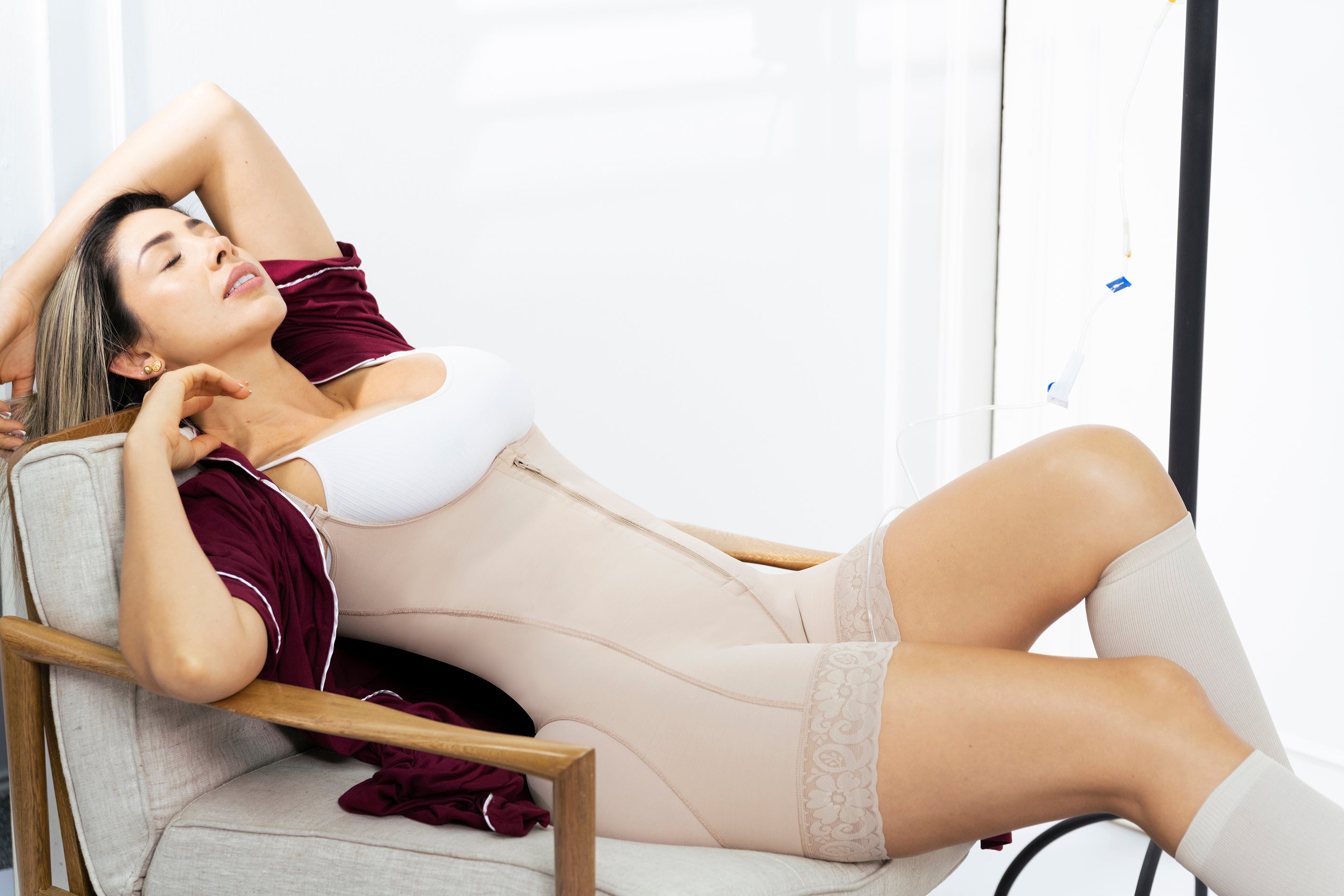Maximizing Comfort & Healing: Your Guide to Post-Tummy Tuck Compression Garments

Discover the perfect fit for your post-tummy tuck compression garment. Ensure comfort and safety during your tummy tuck recovery with our expert tips.
Welcome to our in-depth guide on post-tummy tuck compression garments, an essential aspect of your recovery journey. Undergoing a tummy tuck, or abdominoplasty, is a significant step towards achieving your desired body contours. However, the journey doesn't end with surgery; it extends into a critical recovery period. A key player in this phase is the compression garment, a tool that goes beyond the realm of ordinary clothing to become an integral part of your healing process.
Understanding the role of a compression garment in your post-tummy tuck recovery is crucial. It's not merely about wearing something tight; it's about wearing a garment that supports and enhances the healing process. The right compression garment can make a substantial difference in your comfort levels, the speed of your recovery, and even the final aesthetic results of your surgery.
In this guide, we will delve into the nuances of selecting the right compression garment following a tummy tuck. This includes understanding the ideal tightness and fit, which are pivotal for not only ensuring comfort but also for safeguarding against potential post-surgery complications. A garment that's too tight can hinder circulation and cause discomfort, while one that's too loose won't provide the necessary support to your healing tissues.
We'll provide you with comprehensive insights into how to find a compression garment that strikes the perfect balance between snugness and comfort. This balance is key to minimizing swelling, improving blood circulation, and supporting the newly contoured area. Additionally, we will address how to adjust your garment as your body heals and changes shape in the weeks following the surgery.
Safety is paramount in your recovery journey. Hence, we'll also guide you through recognizing the signs that indicate if your compression garment is too tight and what steps to take if you encounter such issues. Plus, we'll share tips on how to wear and maintain your compression garment, ensuring it remains an effective ally throughout your recovery.
Join us as we navigate the path to a successful recovery post-tummy tuck. Your comfort and safety are our priorities, and this guide aims to provide you with all the information you need to make informed decisions about your post-surgical care.
Compression garments play a pivotal role in the recovery process after a tummy tuck (abdominoplasty). These specially designed pieces of clothing are not just for cosmetic purposes; they serve several crucial medical functions that significantly enhance the healing process.
- Reducing Swelling and Fluid Accumulation: After a tummy tuck, it's common for the body to respond to the surgical trauma by swelling. Compression garments apply steady pressure to the abdominal area, which helps in minimizing this swelling. By compressing the tissues, these garments reduce the space available for fluids to accumulate, thereby preventing excessive swelling and seroma formation (a condition where fluid builds up under the skin).
- Improving Blood Circulation: Good blood circulation is vital for healing. Compression garments aid in maintaining a steady blood flow through the surgical area. This improved circulation not only speeds up the healing process by ensuring a consistent supply of oxygen and nutrients to the tissues but also helps in reducing the risk of blood clots, a common concern after major surgeries like a tummy tuck.
- Supporting and Stabilizing the Surgical Area: A tummy tuck involves the tightening of abdominal muscles and the removal of excess skin. Compression garments provide the necessary support to these areas as they heal. This support is crucial for maintaining the correct posture, reducing strain on the surgical site, and helping the body adapt to its new contours. It also plays a role in minimizing the stress on incisions, which can aid in producing a finer, less noticeable scar.
- Enhancing Comfort and Mobility: Although it might seem counterintuitive, wearing a compression garment can increase your comfort levels during recovery. By providing support and reducing swelling, these garments can make it easier to move around and engage in daily activities. This increased mobility is essential for preventing complications like blood clots and for promoting overall well-being during the recovery phase.
- Contributing to Final Results: The consistent use of a compression garment during the recovery phase can influence the outcome of the surgery. By controlling swelling and supporting the tissues, these garments help in shaping the abdomen and ensuring that the results of the tummy tuck are as intended by the surgeon.
Choosing the Right Compression Garment
- Variety of Garments: Compression garments come in various forms such as bodysuits, abdominal binders, and high-waisted compression shorts. The choice depends on the extent of your tummy tuck and personal comfort preferences.
- Material Considerations: Look for breathable, flexible fabrics that offer firm compression without causing skin irritation. Materials like Lycra, spandex, and certain blends of cotton are popular for their elasticity and comfort. Ensure the garment has a soft lining to prevent skin irritation.
- Accurate Measurement: It's vital to measure your body accurately to choose the right size. A garment that's too small will be uncomfortably tight, while one that's too large won't provide adequate compression.
- Consult with Professionals: Many brands offer sizing charts, but it's also advisable to consult with your surgeon or a professional fitter to ensure the best fit.
- Balance Between Comfort and Compression: The garment should be snug but not overly tight. You should be able to breathe comfortably and move without restriction.
- Monitoring Body Changes: As swelling reduces, the garment may become looser. Regularly assess the fit and consider downsizing if necessary to maintain effective compression.
- Phased Approach: Your surgeon may recommend transitioning to different types of compression garments as you progress through recovery.
- Listening to Your Body: Be attentive to how your body feels. If the garment becomes uncomfortable or loose, it may be time for a change.
- Recognizing Red Flags: Symptoms like numbness, tingling, excessive discomfort, or skin changes under the garment are warning signs. This could indicate that the garment is too tight.
- Immediate Action: If you experience any adverse symptoms, remove the garment and consult your surgeon immediately.
- Surgeon’s Recommendations: Your surgeon will provide specific recommendations based on your individual surgery and recovery process.
- Personalized Fitting: A professional fitting may be beneficial, especially if your body shape changes significantly during recovery.
- Daily Life Adjustments: Plan your wardrobe around your compression garment. Choose clothes that are easy to put on and remove, and consider how often you'll need to adjust or remove the garment during the day.
- Activity Level: Be mindful of your activity level while wearing the garment. Avoid strenuous activities that could cause discomfort or shift the garment's position.
- Care and Cleaning: Follow the manufacturer's instructions for washing and drying your compression garment. Hand washing and air drying can often extend the life of the garment.
- Spare Garments: Having more than one compression garment can be helpful, allowing you to wear one while the other is being washed.
For those looking for the right compression garment after a tummy tuck, here are some recommendations that offer a variety of options to suit different needs and preferences. Here are some recommended fajas from their collection:
- Tummy Tuck Post-Surgery and Daily Use Shapewear with Flat Zipper, Open Bust, & Medium Compression Diane & Geordi 2396: This shapewear is available in beige and black. It is designed for post-surgery and daily use, offering medium compression.
- Post-Surgery Tummy Tuck Faja with Bathroom-Friendly Crotch & High Compressive Fabrics MYD 0161: It features a bathroom-friendly crotch and is made from high-compressive fabrics, suitable for post-surgery use.
- Post-Surgery Tummy Tuck and Postpartum Natural-Birth Faja Bodysuit Medium to High Compression and Innovative Design for Optimal Recovery MYD 0065: It offers medium to high compression and is designed for optimal recovery post-surgery and postpartum.
- Post-Surgery Tummy Tuck Faja with High Compression, High-Back, & Knee-Length MariaE 9382: It provides high compression and features a high-back and knee-length design, ideal for post-surgery recovery.
- Postpartum C-Section and Post-Surgery BBL Support with Built-in Bra, High Back & Medium Compression Fajas Sonryse 053ZL: it comes in multiple colors including beige, mocha, black, chocolate, and black ash. It's designed for postpartum C-section and post-surgery BBL support, featuring a built-in bra and high back.
- Tummy Tuck and Thigh Liposuction Post-Surgery Faja with Closure System, Bathroom-Friendly Crotch & High Compression Salome 0520: comes in beige and black. It is specifically designed for tummy tuck and thigh liposuction post-surgery recovery and features a closure system and bathroom-friendly crotch.
Each of these options provides different levels of support and compression, catering to the varied needs post-tummy tuck surgery. It's important to choose a faja that aligns with your specific recovery needs and comfort preferences.
Your journey to recovery after a tummy tuck is an integral part of the transformative process. It's a time when your body heals and adapts to the changes brought about by the surgery. In this crucial phase, a well-fitted compression garment becomes your companion, playing a vital role in ensuring a smooth and successful recovery. It’s important to remember that the recovery phase is as pivotal as the surgery itself, and the choices you make during this time can significantly impact the overall outcome of your procedure.
The role of a compression garment in your post-tummy tuck recovery cannot be overstated. It’s designed to provide support to your surgical area, reduce swelling, and aid in the proper healing of your tissues. However, finding the right balance between tightness for effective support and comfort for your healing body is essential. A garment that is too tight might hinder your recovery, causing discomfort or even complications. On the other hand, a garment that is too loose will fail to provide the necessary support, potentially affecting the final results of your surgery.
Safety and comfort should be your guiding principles when selecting and wearing a compression garment. It’s important to listen to your body and be aware of how you feel while wearing the garment. Discomfort, pain, or any unusual symptoms should be taken seriously and addressed promptly.
Consulting your surgeon for personalized advice on the type of garment, the duration of wear, and the fit is crucial. Surgeons, with their in-depth understanding of your specific surgical procedure and recovery process, can provide invaluable guidance tailored to your individual needs.
If you ever find yourself unsure about the fit or suitability of your compression garment, don’t hesitate to seek professional help. A garment that fits well not only enhances your comfort but also optimizes your healing process.
We encourage you to share your experiences and tips in the comments below. Your insights could be immensely helpful to others embarking on a similar journey. Additionally, join our community to access more comprehensive guides and receive support throughout your recovery journey. Remember, your experiences and the choices you make during this time are invaluable, not just for your healing but also for the collective knowledge of those who will follow in your footsteps.








